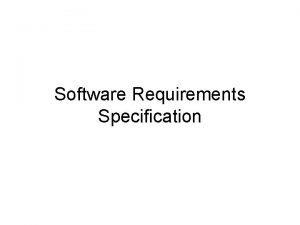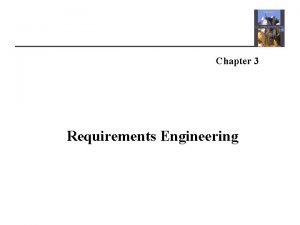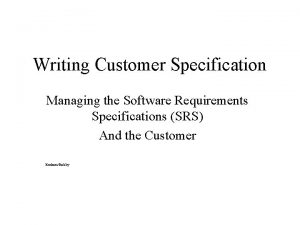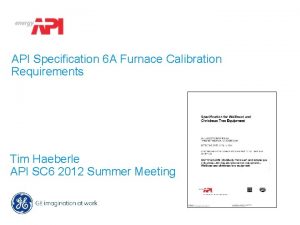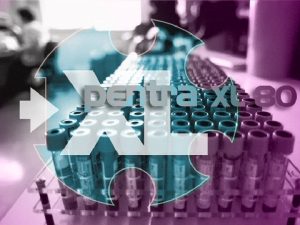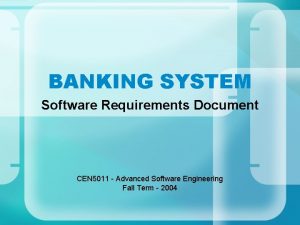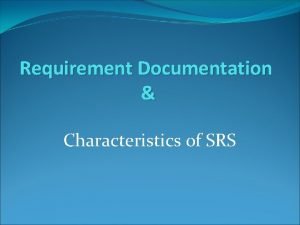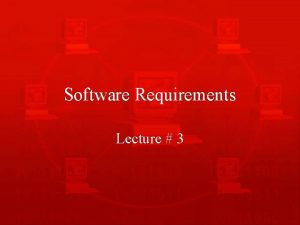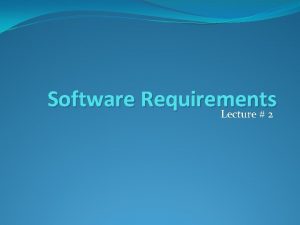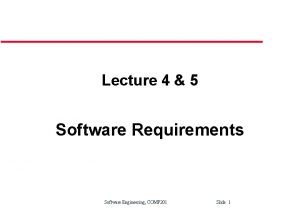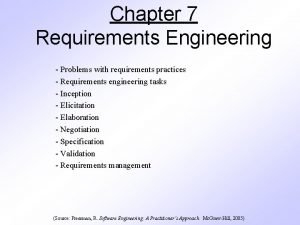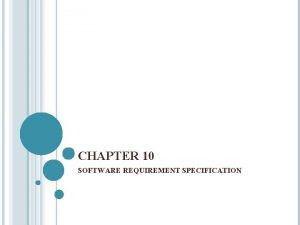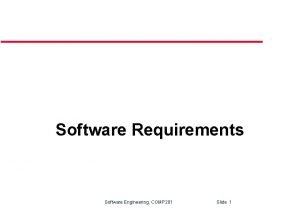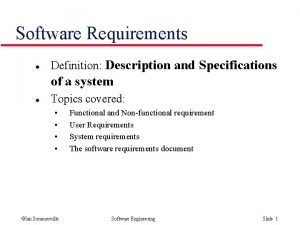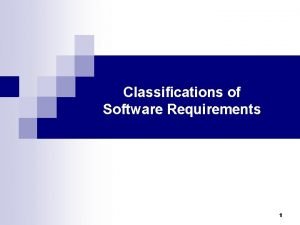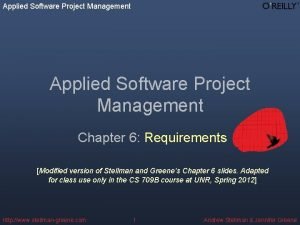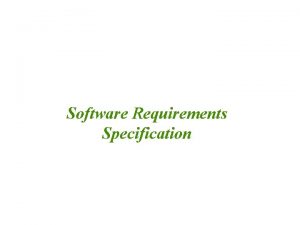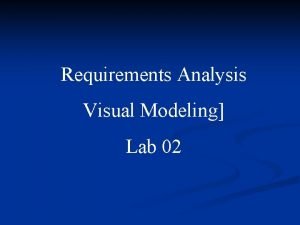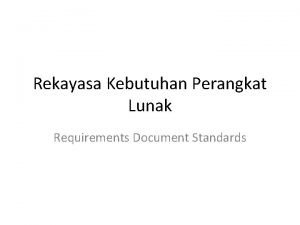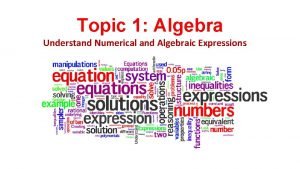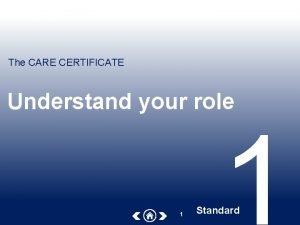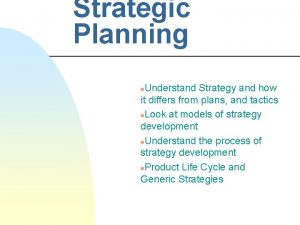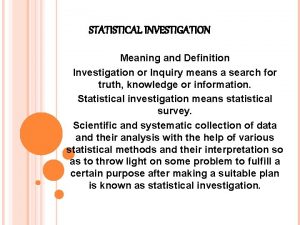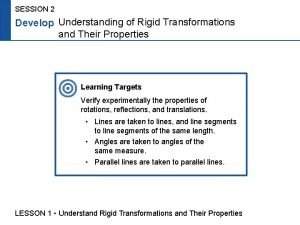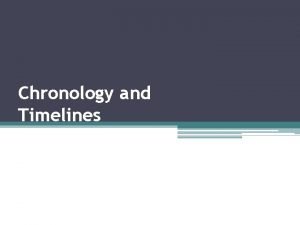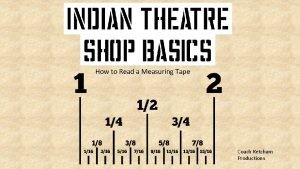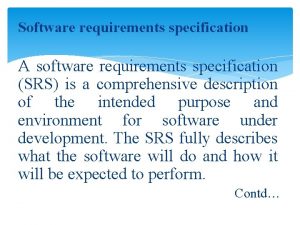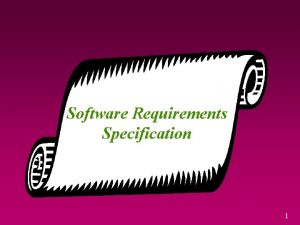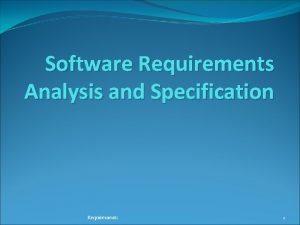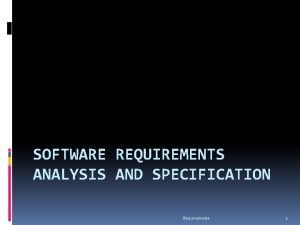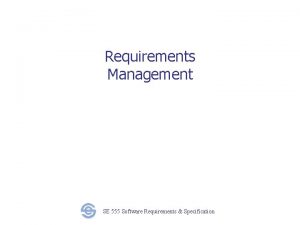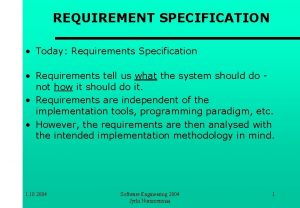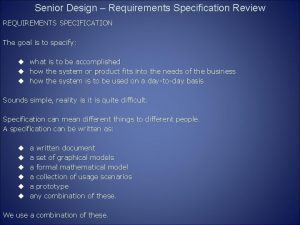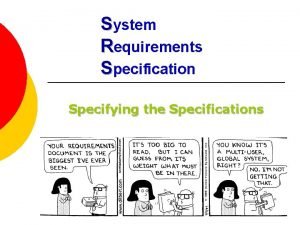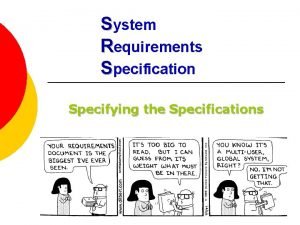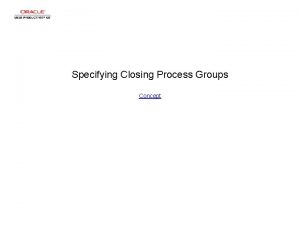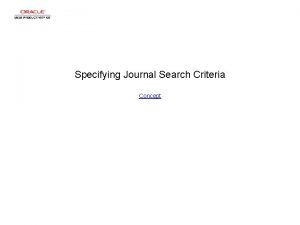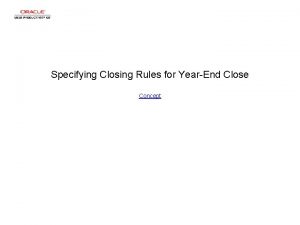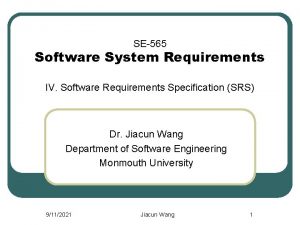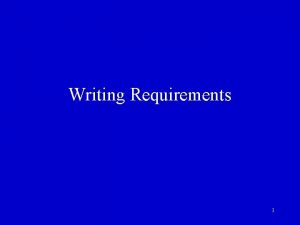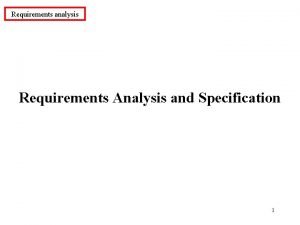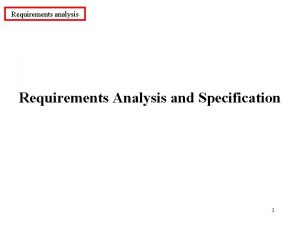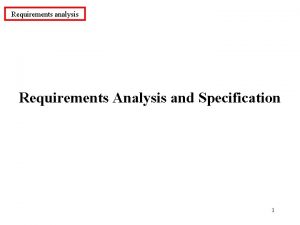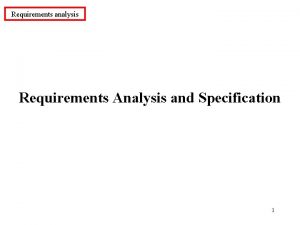Software Requirements Specification 1 Understand specifying requirements A































































- Slides: 63

Software Requirements Specification 1







Understand specifying requirements �A problem of scale �For small scale: understand specifying requirements is easy �For large scale: very hard; probably the hardest, most problematic and error prone �The requirements task: �Input: User needs in minds of people (hopefully) �Output: precise statement of what the future system will do 8

Challenges • Identifying and specifying requirements • Necessarily involves people interaction • Cannot be automated 9

Background. . • What is a Requirement? • A condition or capability that must be possessed by a system (IEEE) • What is the work product of the Req. phase ? • A software requirements specification (SRS) document • What is an SRS ? • A complete specification of what the proposed system should do! 10

Background. . • Requirements understanding is hard • Visualizing a future system is difficult • Capability of the future system not clear, hence needs not clear • Requirements change with time • … • Essential to do a proper analysis and specification of requirements 11

Purpose of SRS document? SRS establishes basis of agreement between the user and the supplier. Users needs have to be satisfied, but user may not understand software Developers will develop the system, but may not know about problem domain SRS is the medium to bridge the communications gap, and specifies user needs in a manner both can understand 12

Need for SRS… �Helps user understand his needs. �users do not always know their needs �must analyze and understand the potential �The requirement process helps clarify needs �SRS provides a reference for validation of the final product �Clear understanding about what is expected. �Validation - “ SW satisfies the SRS “ 13

Need for SRS… • High quality SRS essential for high Quality SW • Requirement errors get manifested in final sw • To satisfy the quality objective, must begin with high quality SRS • Requirements defects cause later problems • 25% of all defects in one study; 54% of all defects found after user testing • defects often found in previously approved SRS. 14

Need for SRS… Good SRS reduces the development cost SRS errors are expensive to fix later Req. changes can cost a lot (up to 40%) Good SRS can minimize changes and errors Substantial savings; extra effort spent during req. saves multiple times that effort An Example Cost of fixing errors in req. , design , coding , acceptance testing and operation are 2 , 5 , 15 , 50 , 150 person-months 15







Organization of SRS 1. Introduction 1. 1 1. 2 1. 3 1. 4 1. 5 Purpose Scope Definition, Acronyms and abbreviations References Overview



Introduction • The Software Requirement Specification(SRS) document provides an overview of the entire SRS. • Purpose: • Identify the purpose of SRS and its intended audience. • Scope: • Identify the software products to be produced by name. • Explain what the software products will, and, if necessary, will not do. • Describe the application of the software being specified, including relevant benefits, objective and goals • Be consistent with similar statement in higher level specification if the exist.

Introduction CONTD………………. • Definition, Acronyms, and Abbreviations: • Provide definition of all terms, acronyms, and abbreviations required to properly interpret the SRS. • This information may be provided by reference to an appendix. References: • Provide complete list of all documents referenced elsewhere in the SRS. • Identified each document by title, report number, date, and publishing organization. • Specify the sources from which the reference can be obtained.

Introduction CONTD………………. • Overview: o Describe what the rest of the SRS contains. o Explain how the SRS is organised.

The overall description • Describe the general factors that affects the product and its requirements. • Product Perspective: • Put the product into perspective with other related products. • If the product is independent and totally selfcontained, it should be so stated here. • If the SRS defines a product that is a component of a larger system, as frequently occurs, then it relates the requirements of the larger system to functionality of the software and identifies interfaces between that system and the software.

The overall description contd…… The following subsection describe how the software operates inside various constraints: • System Interface: • List each system interface and identify the functionality of the software to accomplish the system requirement. • And the interface description to match the system.

The overall description contd…… • Interfaces: • It specify the logical characteristic of each interface between the software product and its users. • All the aspects of optimising the interface with the person who must use the system. • Hardware Interfaces: • Specify the logical characteristics of each interface between the software product and hardware component of the system. • This also includes configuration characteristics.

The overall description contd…… • Software interfaces: • Specify the use of other software products and interface with other application system. • It includes • Name • Specification number • Version number • Source

The overall description contd…… • Communication Interfaces: • Specify the various interfaces to communications such as local network protocols, etc. • Memory constraints: • Specify any applicable characteristics and limits on primary and secondary memory.

The overall description contd…… • Operations: • Specify the normal and special operations required by the users such as: • The various mode of operation in the user organization. • Periods of interactive operations and periods of unattended operations. • Data processing support functions • Backup and recovery operations

The overall description contd…… • Site Adaption Requirements: • Define the requirement for any data or initialization sequences that are specific to a given site, mission, operational mode. • Specify the site or mission related feature that should be modified to adapt the software to a particular installation.

Product function • Provide a summary of the major functions that the software will perform. • The function should be organised in a way that makes the list of functions understandable to the customer or to any one else reading the document for the first time. • Textual or graphic methods can be used to show the different function and their relationship.

User characteristics • Describe those general characteristic of the intended users of the product including educational level, experience, and technical expertise

constraints • Provide a general description of any other items that will limit the developer’s options. These can include: • • • Regulatory Policies Hardware Limitation Interface to other Application Parallel Operation Audit Function Control Function Higher Order Language Requirements Signal Handshake Protocols Reliability Requirements Criticality of the Application Safety and Security Considerations

Assumption and dependencies • List each of the factors that affects the requirements stated in SRS • These factors are not designed constraints on the software but, any change to them may that can affect requirements in SRS.

Apportioning of requirements • Identify requirements that may be delayed until future version of the system.

Specific Requirements • Specific requirements should be stated with all the characteristics of the good SRS. • • Correct Unambiguous Complete Consistent Ranked for importance and stability Verifiable Modifiable Traceable • Specific requirement should be cross-referenced to earlier documents that relate. • All requirements should uniquely identifiable. • Careful attention should be given to organising the requirement to maximize readability.

External interface • This contains a detailed description of all the input into and output from the software system. • It contains both content and format as follow: • • • Name of item Description of purpose Source of input or destination of output Valid range, accuracy and tolerance Units of measure Timing Relationship to other Input/Outputs Screen formats Window formats Data formats Command formats End message

Functions • Functional requirements defines the fundamental action that must take place in software in accepting and processing the inputs and in processing and generating the outputs. These includes: • Validity checks on the inputs • Exact sequence of operations • Response to abnormal situation, including • Overflow • Communication facilities • Error handling and recovery • Effects of parameters • Relationship of output to inputs, including • Input/output Sequences • Formulas for input to output conversion.

Performance Requirements • This subsection specifies both the static and the dynamic numerical requirements placed on the software. • Static numerical requirements may include: • The number of terminals to be supported. • The number of simultaneous users to be supported. • Amount and types of information to be handled. • Dynamic numerical requirements may include: • Number of transactions and tasks and the amount of data to be processed within certain time periods for both normal and peak workload conditions.

Logical database requirements • This section specifies the logical requirements for any information that is to be placed into a database. This may include: • • • Types of information used by various functions Frequency of use Accessing capabilities Data entities and their relationship Integrity constraints

Design constraints • Specify design constraints that can be imposed by other standards, hardware limitations, etc. • Standard Compliance: • Specify the requirements derived from existing standards or regulations. • • Report format Data naming Accounting procedure Audit tracing

Software system attributes • There a number of quality attribute of software that can serve as requirements. • Reliability: • Specify the factor required to establish the required reliability of the software system at time of delivery. • Availability: • Specify the factors required to guarantee a defined availability level for the entire system such as check point, recovery and restart.

Software system attributes contd…… • Security: • Specify the factor that would protect the software form accidental or malicious access, use, modification, destruction. This may include need to: • Utilizing certain cryptographic techniques • Keep specific lo or history data sets • Assign certain functions to different modules • Restrict communication between some areas of the program • Check data integrity for critical variable

Software system attributes contd…… • Maintainability: • Specify attribute of software that relate to the ease of maintenance of software itself. • There may be some requirement for certain modularity, interface, complexity, etc. • Portability: • Specify attributes of software that relates to the ease of parting the software to other host machine and operating systems. This may include: • • • Percentage of component with host dependent code Percentage of code that is host dependent Use of a proven portable language Use of a particular compiler Use of a particular operating system.

Organising the specific requirements • System Mode: • Some system behave quite differently depending on the mode of operation. There are two possible outlines. • The choice depends on whether interfaces, • Performance are dependent on mode. • User Class: • Some system provide different sets of functions to different class of users. • Objects: • Object are real world entities that have a counterpart within the system. • Associated with each object is a set of attributes and functions. • These functions are called services, methods, or processes.

Organising the specific requirements contd… • Feature: • A feature is an externally desired service by the system that may require a sequence of inputs to effect the desired result. • Each feature is described as sequence of stimulusresponse pairs. • Stimulus: • Some system can be best organised by describing their functions in terms of stimuli. • Response: • Some system can be best organised by describing their function in support of the generation of the response.

Change Management Process: • Specify the change management process to be used to identify, log, evaluate, and update the SRS to reflect changes in project scope and requirement.

Document approval • Identify the approvers of the SRS documents. Approver’s name, signature, and date should be used.

Supporting information • The supporting information makes the SRS easier to use. It includes: • Table of contents • Index • Appendices

SRS • 1. 0 INTRODUCTION This document specifies all the requirements for • 1. 1 Purpose The purpose of the …is to …. The system should assist …. The intended audience for this document is … This specification describes …. . • 1. 2 Scope This document applies only to …. . . This specification is not concerned with …. . 54

SRS • 1. 3 Definitions, Acronyms, and Abbreviations SRS - Software Requirements Specifications IEEE - Institute of Electrical and Electronic Engineering • 1. 4 Reference [1] IEEE 830 -1993: IEEE Recommended Practice for Software Requirements Specifications" IEEE Standards Collection, IEEE, 1997. • 1. 5 Overview In the following sections of this specification……will be presented. In Section 2, the general product and its functions will be introduced. 55

SRS In Section 3, all detailed requirements will be specified and grouped. In Appendix ……. 2. 0 GENERAL DESCRIPTION 2. 1 Product Perspective This system allows stakeholders to…. . The system will display…. . The system will help …… The system provides information about …. 2. 2 Product Functions The system provides the following functions: 56

SRS • 2. 3 User Characteristics The users of the system are: • Level of Users’ Computer Knowledge • Level of Users’ Business Knowledge • Frequency of Use • 2. 4 General Constraints The system will support …. The system will not allow …… • 2. 5 Assumption and Dependencies This system relies on …… The system must have a satisfactory interface and …… 57

SRS • SPECIFIC REQUIREMENTS 3. 1 Functional Requirements 3. 1. 1 Unit Registration • The unit registration requirements are concerned with functions regarding unit registration which includes students selecting, adding, dropping, and changing a unit. • SRS-001 (3. 1. 1. 1): • The system shall allow the user to register a unit. • SRS-002 (3. 1. 1. 2): • System shall allow the user to delete a unit if the user has chosen to drop that unit. • SRS-003 (3. 1. 1. 3): • System shall check if a unit has been filled by enough registered students. 58

SRS • SRS-004 (3. 1. 1. 4): • System shall allow the user to add his/her name to the unit waiting list if the user wants to register in a unit which has been filled already with enough registered students. • SRS-005 (3. 1. 1. 5): • System shall automatically register the unit for the user who is the first one on the waiting list if a vacancy appears for that unit. • SRS-006 (3. 1. 1. 6): • System shall allow the user to change practical session(s) within a unit. • SRS-007 (3. 1. 1. 7): • System shall allow the user to change tutorial session(s) within a unit. 59

SRS • 3. 1. 2 Retrieving and Displaying Unit Information • The retrieving and displaying requirements are concerned with how information is retrieved and presented to the user. • SRS-014 (3. 1. 2. 1): • The system shall allow users to enter the following selection criteria to retrieve unit information: by unit code, by unit number, by title of unit, by weight of unit (credit points). • OR by unit code (3. 1. 2. 1. 1) , by unit number (3. 1. 2) , by title of unit (3. 1. 2. 1. 3) , by weight of unit (credit points) (3. 1. 2. 1. 4). 60

SRS • 3. 2 Design Constraints • SRS-031 (3. 2. 1): • System shall store and retrieve persistent data. • SRS-032 (3. 2. 2): • System shall support PC and/or UNIX platforms. • SRS-033 (3. 2. 3): • System shall be developed using the JAVA programming language 61

SRS • 3. 3 Non-Functional Requirements • SRS-034 (3. 3. 1): • System shall respond to any retrieval in less than 5 seconds. • SRS-035 (3. 3. 2): • System shall generate a report within 1 minute. • SRS-036 (3. 3. 3): • System shall allow the user to remotely connect to the system. • SRS-041 (3. 3. 8): • The system will be accompanied by a comprehensive user manual. 62

• 3. 5. 3 Security • The security requirements are concerned with security and privacy issues. SRS-029: • System shall provide staff ID and password verification protection to protect from unauthorised use of the system. SRS-030: • System shall allow the store manager to add, remove and modify staff ID and passwords as required. 63
 To understand recursion you must understand recursion
To understand recursion you must understand recursion Requirement specification
Requirement specification Purpose of research questions
Purpose of research questions Specifying the distribution tasks
Specifying the distribution tasks If lclp is negative number, we set the lclp = 0. why?
If lclp is negative number, we set the lclp = 0. why? Natural variations operations management
Natural variations operations management Which software
Which software System requirements specification
System requirements specification Customer specification
Customer specification Volere shell
Volere shell Sae ams2750
Sae ams2750 Ambulance dispatch system requirements specification
Ambulance dispatch system requirements specification Domain requirements examples
Domain requirements examples Product specification software
Product specification software Software requirement specification for banking system
Software requirement specification for banking system Srs characteristics
Srs characteristics Srs document
Srs document Software requirement analysis and specification
Software requirement analysis and specification Out of specification software
Out of specification software Srs example
Srs example Inverse requirements
Inverse requirements Inverse requirements example
Inverse requirements example High level requirements
High level requirements Requirements discovery techniques in software engineering
Requirements discovery techniques in software engineering What is domain requirements in software engineering
What is domain requirements in software engineering What are functional requirements in software engineering
What are functional requirements in software engineering Seven distinct tasks to requirements engineering
Seven distinct tasks to requirements engineering Value of good srs in software engineering
Value of good srs in software engineering Comp 201
Comp 201 Software requirements definition
Software requirements definition Persyaratan spesifikasi perangkat
Persyaratan spesifikasi perangkat Sink software
Sink software Types of software requirements
Types of software requirements Applied software project management
Applied software project management Srs prototype outline
Srs prototype outline Visual models for software requirements
Visual models for software requirements System requirements document
System requirements document History helps us understand people and society
History helps us understand people and society Quran easy to understand
Quran easy to understand Understand quran
Understand quran Understand quran and salah the easy way
Understand quran and salah the easy way Understand algebraic expressions
Understand algebraic expressions Understand your role
Understand your role Generic strategies examples
Generic strategies examples What is meant by statistical investigation
What is meant by statistical investigation Understand quran and salah the easy way
Understand quran and salah the easy way Understand rigid transformations
Understand rigid transformations How to understand scale drawings
How to understand scale drawings It is pointed out in the reading that opera ----.
It is pointed out in the reading that opera ----. Findings of qualitative research
Findings of qualitative research Je, tu, il/elle nous, vous, ils/elles endings
Je, tu, il/elle nous, vous, ils/elles endings They are highly exposed to and actively using media
They are highly exposed to and actively using media Seek first to understand, then to be understood - ppt
Seek first to understand, then to be understood - ppt Make me understand
Make me understand Bc and ad on a timeline
Bc and ad on a timeline Learn quran and salah the easy way
Learn quran and salah the easy way Understand quran and salah
Understand quran and salah Www.understand quran and salah
Www.understand quran and salah Www.understand quran and salah
Www.understand quran and salah We must first seek to understand
We must first seek to understand How to understand and apply the old testament
How to understand and apply the old testament Coach tape measure
Coach tape measure What does critical reading mean
What does critical reading mean How can paleontologists help us understand the past
How can paleontologists help us understand the past

